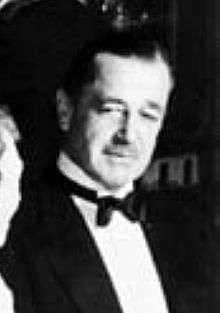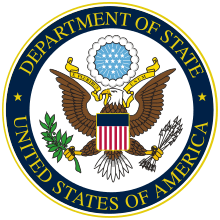Ray Atherton
Ray Atherton (March 28, 1883 – March 14, 1960) was a United States diplomat who served as the first United States Ambassador to Canada (1943–48).
Ray Atherton | |
|---|---|
 | |
| 1st United States Ambassador to Canada | |
| In office November 19, 1943 – August 30, 1948 | |
| President | Franklin D. Roosevelt Harry S. Truman |
| Preceded by | Himself (as Minister) |
| Succeeded by | Laurence Steinhardt |
| United States Minister to Luxembourg | |
| In office September 10, 1943 – October 14, 1943[lower-alpha 1] | |
| President | Franklin D. Roosevelt |
| Preceded by | Jay Pierrepont Moffat |
| Succeeded by | Rudolf Emil Schoenfeld (acting) |
| 8th United States Minister to Canada | |
| In office August 3, 1943 – November 19, 1943 | |
| President | Franklin D. Roosevelt |
| Preceded by | Jay Pierrepont Moffat |
| Succeeded by | Himself (as Ambassador) |
| United States Minister to Denmark | |
| In office September 8, 1939 – April 9, 1940[lower-alpha 2] | |
| President | Franklin D. Roosevelt |
| Preceded by | Alvin M. Owsley |
| Succeeded by | R. Borden Reams (acting) |
| United States Minister to Bulgaria | |
| In office October 21, 1937 – July 5, 1939 | |
| President | Franklin D. Roosevelt |
| Preceded by | Frederick A. Sterling |
| Succeeded by | George Howard Earle III |
| Personal details | |
| Born | March 28, 1883 Brookline, Massachusetts, U.S. |
| Died | March 14, 1960 (aged 76) Washington, D.C., U.S. |
| Cause of death | Cerebral hemorrhage |
| Spouse(s) | Constance Crowninshield Coolidge Maude Hunnewell |
| Education | Harvard College |
| Profession | Diplomat |
Biography
Ray Atherton was born in Brookline, Massachusetts in 1883.[1] He was educated at Harvard College, graduating with a B.A. in 1905.[1] He then moved to Paris to study architecture, becoming known as the "beau of the Beaux-Arts".[1] Returning to Boston, Atherton spent time working as a banker and as an architect.[1] [2]
In 1917, Atherton joined the U.S. diplomatic service as a secretary of legation in Peking. He was married for a time to Constance Crowninshield Coolidge, a Boston Brahmin, an American expatriate and French countess. Constance didn't care what others thought about her. She loved anything risky and was addicted to gambling.[3]:214 Atherton also served on the Philippine Commission and at the United States Department of State in Washington, D.C.[1] He was then posted to Athens and in 1923-24, served as ad interim United States Ambassador to Greece.[1][2]
Atherton then moved to London and worked at the U.S. Embassy in London for twelve years, first as secretary, and then, from 1930 to 1937 as counselor.[1] When Cordell Hull became United States Secretary of State in 1933, he was impressed by Atherton and came to rely on his judgment on European and Middle Eastern affairs. Atherton also was an adviser at the London Naval Conferences of 1930 and 1935.[1][2]
In 1937, President of the United States Franklin D. Roosevelt appointed Atherton Minister Plenipotentiary to Bulgaria.[1] Atherton presented his credentials on October 21, 1937, and served there until July 5, 1939.[1] He then became Minister Plenipotentiary to Denmark, serving there from September 8, 1939 until June 5, 1940. As such, he was present in Denmark at the time of the German invasion of Denmark.[1][2]
Cordell Hull then recalled Atherton to Washington, D.C., where, as head of the European Division, he became one of Hull's closest advisers.[1] It was Atherton who, on the morning December 12, 1941, received Germany's official declaration of war delivered by German Charge d'Affaires Hans Thomsen after Hull refused to see him.[4]
In June 1943, the United States and Canada agreed to upgrade the state of their mutual diplomatic missions from legation to embassy.[1] Atherton thus became the first United States Ambassador to Canada, presenting his credentials to Alexander Cambridge, 1st Earl of Athlone, the Governor General of Canada, on August 3, 1943 and serving until August 30, 1948. He was also accredited as minister to the government in exile of Denmark, which was established in Canada during the German occupation of Denmark.[1] Atherton was also named U.S. minister to the government in exile of Luxembourg, which was also under German occupation.[1]
In August 1948, Atherton was accredited as an alternate U.S. delegate to the United Nations General Assembly, which was then meeting in Paris.[1]
Personal
Atherton was the son of George Edward Atherton (1845-1905) and Isabelle Rea. His grandfather was Samuel Atherton, Massachusetts businessman and politician.
He was married to the former Maude Hunnewell. Together they had a son, John, and a daughter, Maud Isabel Atherton Wood.[1]
Atherton died in Washington, D.C., of a cerebral hemorrhage on March 14, 1960.[1]
Ancestry
Atherton is a direct descendant of Major General Humphrey Atherton. [5]
Notes
- The Luxembourg government in exile moved to London, thereby terminating Atherton's appointment.
- Although Atherton would remain at his post until June 5, 1940, the German invasion of Denmark terminated Atherton's accreditation to the Danish government.
References
- "Ray Atherton, 76, Diplomat, is Dead", New York Times, March 17, 1960
- "Ray Atherton (1883-1960)". U.S. Department Of State. Retrieved September 27, 2014.
- Geoffrey Wolff (2003). Black Sun: The Brief Transit and Violent Eclipse of Harry Crosby. New York Review of Books. ISBN 1-59017-066-0.
- Hulen, Bertram D. (December 12, 1941). "Hull Very Frigid to Visiting Envoys". New York Times. p. 3.
- "Atherton One Name Study - Ray Atherton - US Ambassador".
External links
- Atherton Address to the Empire Club of Canada Looking Forward to the Postwar World (February 1, 1945)
| Diplomatic posts | ||
|---|---|---|
| Preceded by Frederick A. Sterling |
United States Ambassador to Bulgaria October 21, 1937 – July 5, 1939 |
Succeeded by George Howard Earle III |
| Preceded by Alvin M. Owsley |
United States Ambassador to Denmark September 8, 1939 – June 5, 1940 |
Succeeded by Monnett Bain Davis |
| Preceded by Jay Pierrepont Moffat |
United States Ambassador to Canada August 3, 1943 – August 30, 1948 |
Succeeded by Laurence Steinhardt |
